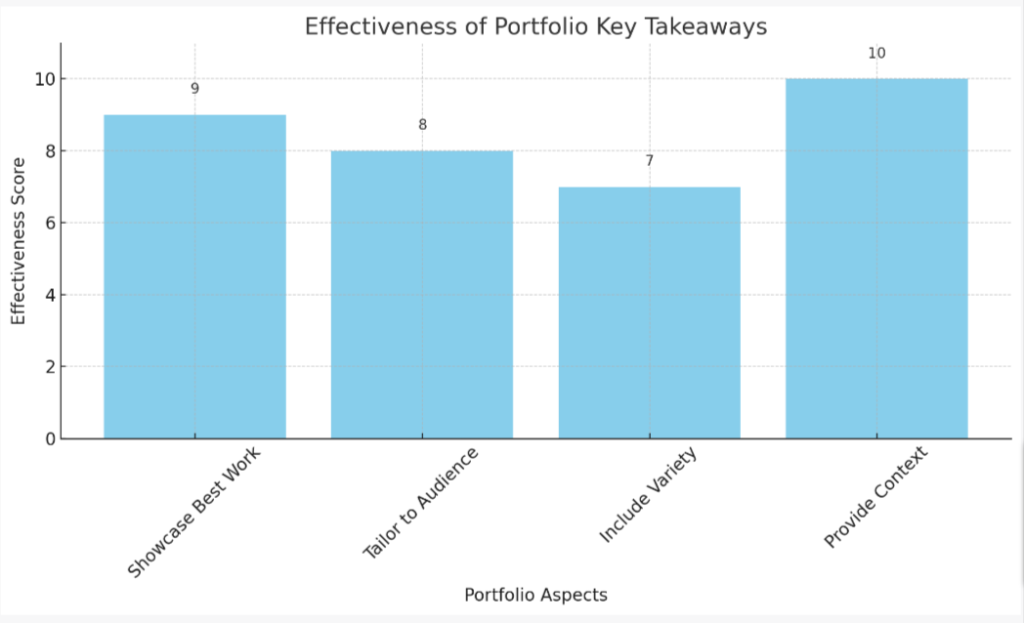Best Practices for Sharing Your Writing Portfolio
Crafting a compelling portfolio can be a daunting task. Did you know that 83% of hiring managers say a portfolio is crucial in their decision process? This blog post will guide you through the do’s and don’ts of showcasing your work, helping to set you apart from the crowd.
Ready to take your portfolio to new heights?.
Key Takeaways
- Showcase your best work to highlight your skills and expertise.
- Tailor your portfolio to your audience to show versatility and meet client needs effectively.
- Include a variety of projects to demonstrate range and keep viewers engaged.
- Provide context and explanations for each project to showcase your thought process and approach.
- Avoid including irrelevant or outdated work that doesn’t align with the job you’re applying for.
- Don’t overwhelm with too much information; focus on quality over quantity.
- Regularly update your portfolio to stay current and showcase growth in your skills.
- Pay attention to design and presentation to create an aesthetically pleasing portfolio.
The Do’s of Sharing Your Portfolio
Showcase your best work, highlighting projects that demonstrate your skills and expertise in the field.
Showcase your best work
Collecting and selecting your best pieces is a crucial step in creating an impressive portfolio. Focus on highlighting the most accomplished projects that reflect your skills, expertise, and passion for the craft.
Your chosen works should not only demonstrate technical abilities but also showcase creativity and problem-solving aptitude. This selection can range from designs you’re proud of to effective solutions you found for challenging tasks.
Always aim to put forth content that mirrors your professional growth, individual style, and dedication towards excellence in each project undertaken. Displaying top-notch work helps potential clients or employers instantly understand what they can expect from collaborating with you.
Tailor your portfolio to your audience
Understanding your audience makes a significant difference in how you present your portfolio. Your target viewers dictate what kind of projects, designs, or styles you should highlight.
For instance, if you’re aiming for a job in a corporate company, it’s advisable to showcase professional work that exhibits your ability to provide formal and structured designs.
By contrast, suppose the intended audience is an innovative tech start-up. In this case, try focusing on displaying creative and out-of-box projects that demonstrate flexibility and adaptability.
Tailoring your portfolio not only shows versatility but also communicates that you can meet different client needs effectively.

Include a variety of projects
Diversifying your portfolio is essential. It’s not just about showing off the range of your skills, but it also grabs attention, keeps viewers engaged and presents a well-rounded picture of what you can do.
You could be great at designing logos, but if that’s all you display, potential clients are left guessing about your capabilities in other areas. Include different examples from web design to print media layouts, brand identity designs to illustrative work.
Even projects like mockups and narrative sketches reveal creativity and versatility. If confidentiality agreements hinder sharing some professional work, try initiating personal projects or non-NDA collaborations for showcasing variety in your portfolio.
Provide context and explanations
When sharing your portfolio, it’s important to provide context and explanations for each project. This helps the viewer understand the purpose, goals, and challenges of your work. By providing a brief narrative or description, you can highlight your role in the project, any notable achievements or learnings, and how it aligns with your overall skillset and expertise.
Additionally, including details about the process you followed and any relevant metrics or results can further enhance the understanding of your work. Remember that providing context and explanations adds depth to your portfolio, showcases your thought process, and gives potential clients or employers insight into how you approach projects.
To avoid confusion or misinterpretation, be concise in your descriptions while still conveying key information. Use clear language that is accessible to a wide audience so that they can easily grasp the value of each project.
The Don’ts of Sharing Your Portfolio
– Don’t include irrelevant or outdated work. Keep your portfolio focused on your best and most recent projects to showcase your current skills and abilities. Want to know the other don’ts? Read on!
Don’t include irrelevant or outdated work
To make your portfolio stand out, it’s crucial to avoid including irrelevant or outdated work. Potential employers or clients are looking for your most current and relevant projects that showcase your skills and expertise.
Including work that is not related to the job you’re applying for can confuse the viewer and dilute the impact of your portfolio. Additionally, outdated work might not accurately reflect your current abilities or design style.
Focus on selecting pieces that demonstrate your strongest capabilities and align with the specific needs of the audience you are targeting.
Don’t overwhelm with too much information
When sharing your portfolio, it’s important to avoid overwhelming your audience with too much information. Keep in mind that people have limited time and attention spans, so it’s best to showcase a curated selection of your best work rather than bombarding them with every project you’ve ever worked on.
Focus on quality over quantity and choose the pieces that are most relevant to the audience you’re trying to reach. By presenting a concise and streamlined portfolio, you’ll make it easier for others to appreciate and understand the value of your work.
Don’t forget to update regularly
Regularly updating your portfolio is essential to keeping it relevant and up-to-date. By regularly adding new projects and removing outdated ones, you can showcase your most recent work and demonstrate growth in your skills and abilities.
This shows that you are actively engaged in your profession and committed to staying current in the industry. Keeping your portfolio updated also ensures that potential clients or employers see a true reflection of your capabilities, increasing the likelihood of securing new opportunities.
So, make it a habit to review and update your portfolio on a regular basis to keep it fresh and impactful.
Don’t neglect design and presentation
Your design and presentation play a crucial role in showcasing your portfolio effectively. Neglecting the overall design and presentation can greatly diminish the impact of your work.
Use clean layouts, visually appealing graphics, and a cohesive color scheme to create an aesthetically pleasing portfolio. Additionally, pay attention to typography and formatting to make your content easy to read and navigate.
Remember that a well-designed portfolio not only grabs attention but also demonstrates your professionalism and attention to detail in your work.
Tips for Sharing Your Portfolio
Create an online portfolio website to showcase your work in a professional and easily accessible way.
Create an online portfolio website
Creating an online portfolio website is essential for showcasing your work effectively. Here are some ways to do it:
- Choose a user – friendly platform or website builder that suits your needs.
- Select a clean and professional design template to enhance the presentation of your work.
- Organize your portfolio in a logical and easy-to-navigate manner, using categories or tags.
- Include high – quality images or videos of your projects to capture attention.
- Write concise and engaging descriptions for each project, highlighting key details and achievements.
- Provide contact information on your website so potential clients or employers can easily reach out to you.
- Regularly update your portfolio with new work and remove any outdated projects.
- Optimize your website for mobile devices to ensure accessibility on various platforms.
Utilize social media and networking platforms
Utilize social media and networking platforms to expand the reach of your portfolio. Here are some ways you can make the most of these platforms:
- Share your work on platforms like Instagram, LinkedIn, and Behance to showcase your talent to a wider audience.
- Engage with others in your industry by joining relevant groups or communities on platforms like Facebook or Reddit.
- Connect with professionals and potential clients by actively participating in discussions and sharing insights on LinkedIn or Twitter.
- Use hashtags strategically to increase visibility and make it easier for people to discover your portfolio.
- Collaborate with other creatives or professionals through social media, which can lead to new opportunities or projects.
Seek feedback from colleagues or mentors
To refine and improve your portfolio, it’s essential to seek feedback from colleagues or mentors. By getting an outside perspective, you can gain valuable insights and identify areas for growth.
Share your portfolio with trusted individuals who have experience in your field, and ask for their honest opinions. They can provide constructive criticism that will help you make necessary adjustments and highlight any weaknesses that need attention.
Receiving feedback is a crucial step towards creating a more impactful portfolio that effectively showcases your skills and expertise.
Utilize testimonials and references
Testimonials and references can be powerful tools for showcasing your skills and credibility. By including positive feedback from clients, employers, or colleagues in your portfolio, you can demonstrate to potential clients or employers that you have a proven track record of success.
Testimonials provide social proof and build trust with your audience, giving them confidence in your abilities. Similarly, references from trusted individuals in your industry can vouch for the quality of your work and serve as an endorsement of your skills.
Including testimonials and references adds depth to your portfolio and enhances its overall impact.
Conclusion
In conclusion, when it comes to sharing your portfolio, there are certain do’s and don’ts to keep in mind. Showcasing your best work, tailoring it to your audience, providing context and explanations, avoiding irrelevant or outdated work, not overwhelming with too much information, updating regularly, paying attention to design and presentation – these are all key factors in making a strong impression with your portfolio.
By following these guidelines and utilizing online platforms and feedback from colleagues or mentors, you can effectively share your portfolio and increase your chances of success.

